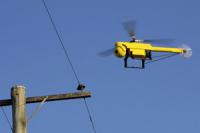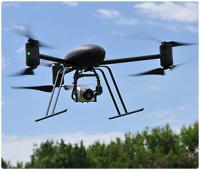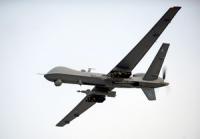-
Securing U.S. skies
Extended stretches of U.S. land borders invite illegal entry on the ground, and U.S. coastlines are often used for unauthorized seaborne entry. New, creative attempts at illegal activity in these domains are a daily occurrence. Aerial threats pose a different challenge as they have no natural barriers restricting them — land or coastal. Commercialization of drone technology, for all the beneficial opportunities it provides, also enables a new medium for criminal activity and other homeland security threats.
-
-
Cambridge Analytica: the data analytics industry is already in full swing
Revelations about Cambridge Analytica have laid bare the seeming lack of control that we have over our own data. Suddenly, with all the talk of “psychographics” and voter manipulation, the power of data analytics has become the source of some concern. But the risk is that if we look at the case of Cambridge Analytica in isolation, we might prevent a much wider debate about the use and control of our data. By focusing on the reports of extreme practices, we might miss the many everyday ways that data analytics are now shaping our lives.
-
-
Use of face recognition systems threatens civil liberties: EFF report
Face recognition—fast becoming law enforcement’s surveillance tool of choice—is being implemented with little oversight or privacy protections, leading to faulty systems that will disproportionately impact people of color and may implicate innocent people for crimes they didn’t commit, says an Electronic Frontier Foundation (EFF) report. Independent oversight, privacy protections are needed.
-
-
Seeking clarity: Making gray-zone activity more black and white
An emergent type of conflict in recent years has been coined “gray zone,” because it sits in a nebulous area between peace and conventional warfare. Gray-zone action is not openly declared or defined, it’s slower, and is prosecuted more subtly—using social, psychological, religious, information, cyber and other means to achieve physical or cognitive objectives with or without violence. The lack of clarity of intent—the grayness—makes it challenging to detect, characterize, and counter an enemy fighting this way. DARPA launches a new program called COMPASS, to develop software that would help clarify enemy intent by gauging an adversary’s responses to various stimuli.
-
-
Germany’s highest court reviewing country’s permissive new surveillance laws
German journalists, press groups, and civil rights advocates have asked Germany’s Constitutional Court to review the legality of the government’s surveillance capabilities. The plaintiffs contend that the law allows for the “virtually unrestricted” monitoring of foreign reporters.
-
-
Drones learn to navigate autonomously by imitating cars, bicycles

Researchers have developed an algorithm called DroNet which allows drones to fly completely by themselves through the streets of a city and in indoor environments. The algorithm had to learn traffic rules and adapt training examples from cyclists and car drivers.
-
-
Detect illicit drone video filming

Researchers have demonstrated the first technique to detect a drone camera illicitly capturing video. Their study addresses increasing concerns about the proliferation of drone use for personal and business applications and how it is impinging on privacy and safety.
-
-
FAA declares seven nuclear research facilities no-drone zones
The Federal Aviation Administration (FAA) has granted a request from the Department of Energy (DOE) to declare seven DOE’s nuclear research facilities no-drone zones. Starting 29 December, drone operators would not be allowed to fly their UAVs within 400 feet of these facilities: The FAA said it is currently considering more “no-drone zone” requests from federal agencies.
-
-
Germany considering requiring home, car alarm systems to be equipped with back doors
The German government will next week discuss sweeping new surveillance powers aimed to improve public safety. The proposal to be discussed would require operators of car and house alarm systems to help police and security services in their efforts to spy on potential terrorists or criminals.
-
-
Mimicking peregrine falcon attack strategies could help down rogue drones
Researchers have discovered that peregrine falcons steer their attacks using the same control strategies as guided missiles. The findings, which overturn previous assumptions that peregrines’ aerial hunting follows simple geometric rules, could be applied to the design of small, visually guided drones that can take down other ‘rogue’ drones in settings such as airports or prisons.
-
-
An armed robber’s Supreme Court case could affect all Americans’ digital privacy for decades to come
A man named Timothy Carpenter planned and participated in several armed robberies at Radio Shack and T-Mobile stores in Michigan and Ohio between 2010 and 2012. He was caught, convicted and sentenced to 116 years in federal prison. His appeal, which was heard by the U.S. Supreme Court on 29 November, will shape the life of every American for years to come – no matter which way it’s decided. The FBI found Timothy Carpenter because one of his accomplices told them about him. I believe the FBI could have obtained a search warrant to track Carpenter, if agents had applied for one. Instead, federal agents got cellphone location data not just for Carpenter, but for fifteen other people, most of whom were not charged with any crime. One of them could be you, and you’d likely never know it. The more people rely on external devices whose basic functions record and transmit important data about their lives, the more critical it becomes for everyone to have real protection for their private data stored on and communicated by these devices.
-
-
Counter UAVs to drive enemy drones out of the sky

Defense drones to seek out and bring down hostile military UAVs are being developed in Australia. Military drones have changed the landscape of the modern battlefield in recent years, but the technology to counter them has not kept pace. Reacting to this gap in the market the startup is developing two models in Adelaide, South Australia. The first is a compact counter UAV drone with metal rotors that can be stored in a soldier’s pack and launched when an enemy drone is believed to be in the area.
-
-
Counter UAVs to drive enemy drones out of the sky
Defense drones to seek out and bring down hostile military UAVs are being developed in Australia. Military drones have changed the landscape of the modern battlefield in recent years, but the technology to counter them has not kept pace. Reacting to this gap in the market the startup is developing two models in Adelaide, South Australia. The first is a compact counter UAV drone with metal rotors that can be stored in a soldier’s pack and launched when an enemy drone is believed to be in the area.
-
-
Developing autonomous drone swarms for urban warfare
DoD has awarded a team of researchers $7.1 million to develop a drone swarm infrastructure to help the U.S. military in urban combat. The goal is to develop a technology which would allow troops to control scores of unmanned air and ground vehicles at a time.
-
-
DNA techniques could transform facial recognition technology
Camera-based visual surveillance systems were supposed to deliver a safer and more secure society. But despite decades of development, they are generally not able to handle real-life situations. During the 2011 London riots, for example, facial recognition software contributed to just one arrest out of the 4,962 that took place. The failure of this technology means visual surveillance still relies mainly on people sitting in dark rooms watching hours of camera footage, which is totally inadequate to protect people in a city. But recent research suggests video analysis software could be dramatically improved thanks to software advances made in a completely different field: DNA sequence analysis. By treating video as a scene that evolves in the same way DNA does, these software tools and techniques could transform automated visual surveillance.
-
- All
- Regional
- Water
- Biometrics
- Borders/Immig
- Business
- Cybersecurity
- Detection
- Disasters
- Government
- Infrastructure
- International
- Public health
- Public Safety
- Communication interoperabillity
- Emergency services
- Emergency medical services
- Fire
- First response
- IEDs
- Law Enforcement
- Law Enforcement Technology
- Military technology
- Nonlethal weapons
- Nuclear weapons
- Personal protection equipment
- Police
- Notification /alert systems
- Situational awareness
- Weapons systems
- Sci-Tech
- Sector Reports
- Surveillance
- Transportation
Advertising & Marketing: advertise@newswirepubs.com
Editorial: editor@newswirepubs.com
General: info@newswirepubs.com
2010-2011 © News Wire Publications, LLC News Wire Publications, LLC
220 Old Country Road | Suite 200 | Mineola | New York | 11501
Permissions and Policies
Editorial: editor@newswirepubs.com
General: info@newswirepubs.com
2010-2011 © News Wire Publications, LLC News Wire Publications, LLC
220 Old Country Road | Suite 200 | Mineola | New York | 11501
Permissions and Policies
